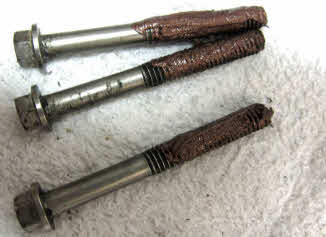Related Resources: material science
Anti-Seize Compound Application Review
Fastener, Bolt and Screw Design Torque and Force Calculations
Anti-seize materials and compounds are used on threads, bolted joints and even ACME thread installation. The goal of anti-seize is to prevent the threads from, well seizing and preventing the normal disassembly of the mechanical joint. Anti-seize compounds are also used to improve gasket performance and removal, prevent thread galling during installation, thermal cycling, dissimilar metal corrosion and protect the joint from highly corrosive environments.
The most correct ant-seize compound to use is application dependent. There are several ant-seize products available. Anti-seize grease which can operate in environments up to 400+ degrees F and there are synthetic solid blends with temperature rating of 3900 degrees F.
 |
|---|
Aluminum and copper based anti-seize are generally known to be the most common used in industry. Copper formulations generally are limited to about 1,750 degrees F and aluminum based ant-seize can be rated up to 1,500 degrees F.
Graphite based anti-seize are used in applications where electrical conductivity is required and/or temperature of about 850 degrees F is encountered. Graphite based anti-seize products are used in applications such as spark plugs, high voltage electrical connections, antenna connection in corrosive environments and offer minimal electrical resistance or voltage loss.
In marine and similar operating environments petroleum or synthetic blends of anti-seize are used to seal the thread or other joint from the harsh environment. With these materials a water washout product is required and can be tested according to ASTM D1264, “Standard Test Method for Determining the Water Washout Characteristics of Lubricating Greases”.
Anti-Seize and Fastener Torque
Anti-seize lubricants act as lubricants and this characteristics should be accounted for when applying torque to screws, nuts, and other threaded connections. Dry threads will have more friction present during the torque process therefore the actual applied to achieve the desired clamp load would be greater than thread lubricated with anti-seize.
See: Fastener Screw Torque Clamp Force Design Equation and Estimated Fastener Bolt Clamp Force Torque Calculator
Fastener torque for threads lubricated with anti-seize should be adjusted based on the anti-seize manufacturers recommendation or by measuring the actual applied clamp force of the mechanical joint. To measure the clamp force you will need to be able to measure the bolt tension or the clamp load directly. Common methods to measure the tension applied to the fastener is to measure the length of the bolt (grip + threaded are under tension) before and after applying torque. Knowing the tensile strength of the bolt one can then calculate the applied clamp force. Another crude method of verifying torque is by marking a line on the fastener (head or nut) and mating part then backing off the fastener 1/4 turn or more then lubricate with anti-seize or grease. Then measure the torque required to tighten the fastener until the lines match up.
Other methods include strain gages, ultrasonic extensometers, measure bolt angular rotation and calculating based on known thread pitch. There are bolt tester machine that can directly measure the the clamp load vs applied torque.
Notes:
• Most standard torque values are based on non-lubricated fasteners.
• Lubricated means coated with a lubricant such as engine oil, thread sealant or thread locker.
• Torque should be reduced appropriately when using anti seize with fasteners where the original torque design did not use anti-seize.
• The nominal torque values listed for Grade 5 & 8 fasteners are based on 75%, of the minimum proof load specified.
• Zinc and copper based anti-seize lubricants are not recommended for use with stainless steels